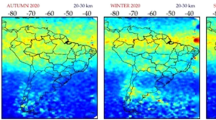Abstract
The radio occultation (RO) observation data provided by the second generation of The Constellation Observing System for Meteorology, Ionosphere and Climate (COSMIC) were used to study and verify the method of determining the tropopause height based on atmospheric refractivity covariance transform. The principle of selecting the scale factor a in the atmospheric refractivity covariance transform is discussed based on the occultation events of GPS and GLONASS. It is found that the vertical variation of the refractivity in the lower troposphere region is smoother when a is taken as 30 km, and the prominent peaks of the refractivity profiles are more conducive to the determination of the tropopause. Comparing the atmospheric refractivity with the covariance-transformed atmospheric refractivity, it is found that the change of latter is more obvious and prominent, which can be used for the determination of the tropopause. According to the RO data in the low, middle and high latitudes, the tropopause heights obtained by the atmospheric refractivity covariance transform was compared with the cold point tropopause (CPT) and the temperature lapse rate tropopause (LRT) heights determined by the occultation temperature profile in the same occultation event, and the results show that there is a remarkable consistency between the three results at different latitudes, which means that the method used to determine the tropopause height after the covariance transformation of the atmospheric refractivity is feasible.
Access this chapter
Tax calculation will be finalised at checkout
Purchases are for personal use only
Similar content being viewed by others
References
Hoinka, K.P.: The tropopause: discovery, definition and demarcation. Meteorol. Z. 6 (1997)
Shepherd, T.G.: Issues in stratosphere-troposphere coupling. J. Meteorol. Soc. Jpn. Ser. II 80(4B), 769–792 (2002)
Appenzeller, C., Holton, J.R., Rosenlof, K.H.: Seasonal variation of mass transport across the tropopause. J. Geophys. Res.: Atmos. 101(D10), 15071–15078 (1996)
Santer, B.D., Wehner, M.F., Wigley, T.M.L., et al.: Contributions of anthropogenic and natural forcing to recent tropopause height changes. Science 301(5632), 479–483 (2003)
Gettelman, A.: A climatology of the tropical tropopause layer. J. Meteorol. Soc. Jpn. Ser. II 80(4B), 911–924 (2002)
Wang, W., Matthes, K., Schmidt, T., et al.: Recent variability of the tropical tropopause inversion layer. Geophys. Res. Lett. 40(23), 6308–6313 (2013)
World Meteorological Organization (WMO): Definition of the tropopause. WMO Bull. 6, Geneva, Switzerland (1957)
Highwood, E.J., Hoskins, B.J.: The tropical tropopause. Q. J. R. Meteorol. Soc. 124(549), 1579–1604 (1998)
Pan, L.L., Honomichl, S.B., Bui, T.V., et al.: Lapse rate or cold point: the tropical tropopause identified by in situ trace gas measurements. Geophys. Res. Lett. 45(19), 10756–10763 (2018)
Schmidt, T., Wickert, J., Beyerle, G., et al.: Tropical tropopause parameters derived from GPS radio occultation measurements with CHAMP. J. Geophys. Res.: Atmos. 109(D13) (2004)
Borsche, M., Kirchengast, G., Foelsche, U.: Tropical tropopause climatology as observed with radio occultation measurements from CHAMP compared to ECMWF and NCEP analyses. Geophys. Res. Lett. 34(3) (2007)
Xian, T., Homeyer, C.R.: Global tropopause altitudes in radiosondes and reanalyses. Atmos. Chem. Phys. 19(8), 5661–5678 (2019)
Seidel, D.J., Ross, R.J., Angell, J.K., et al.: Climatological characteristics of the tropical tropopause as revealed by radiosondes. J. Geophys. Res.: Atmos. 106(D8), 7857–7878 (2001)
Kursinski, E.R., Hajj, G.A., Bertiger, W.I., et al.: Initial results of radio occultation observations of Earth’s atmosphere using the Global Positioning System. Science 271(5252), 1107–1110 (1996)
Melbourne, W.G., Davis, E.S., Duncan, C.B., et al.: The application of spaceborne GPS to atmospheric limb sounding and global change monitoring (1994)
Kursinski, E.R., Hajj, G.A., Schofield, J.T., et al.: Observing Earth’s atmosphere with radio occultation measurements using the Global Positioning System. J. Geophys. Res.: Atmos. 102(D19), 23429–23465 (1997)
Schmidt, T., Wickert, J., Beyerle, G., et al.: Global tropopause height trends estimated from GPS radio occultation data. Geophys. Res. Lett. 35(11) (2008)
Xu, X., Luo, J., Zhang, K.: An analysis of the structure and variation of the tropopause over China with GPS radio occultation data. J. Navig. 64(S1), S103–S111 (2011)
Lewis, H.W.: A robust method for tropopause altitude identification using GPS radio occultation data. Geophys. Res. Lett. 36(12) (2009)
Yuan, L.L., Anthes, R.A., Ware, R.H., et al.: Sensing climate change using the global positioning system. J. Geophys. Res.: Atmos. 98(D8), 14925–14937 (1993)
Xia, P., Shan, Y., Ye, S., et al.: Identification of tropopause height with atmospheric refractivity. J. Atmos. Sci. 78(1), 3–16 (2021)
Gamage, N., Hagelberg, C.: Detection and analysis of microfronts and associated coherent events using localized transforms. J. Atmos. Sci. 50(5), 750–756 (1993)
Acknowledgements
Thanks to the National Natural Science Foundations of China (41764002, 62263023 and 62161002) and the Graduate Innovation Special Fund of Jiangxi province (YC2022-S019) for their support for this paper. Meanwhile, thanks to the COSMIC Data Analysis and Archive Center (CDAAC) for the free data.
Author information
Authors and Affiliations
Corresponding author
Editor information
Editors and Affiliations
Rights and permissions
Copyright information
© 2024 Aerospace Information Research Institute
About this paper
Cite this paper
Ni, T., Guo, H., Xiong, J., Lv, L., Wan, Z. (2024). Identification of Tropopause Height Using COSMIC-2 Occultation Atmospheric Refractivity. In: Yang, C., Xie, J. (eds) China Satellite Navigation Conference (CSNC 2024) Proceedings. CSNC 2024. Lecture Notes in Electrical Engineering, vol 1092. Springer, Singapore. https://doi.org/10.1007/978-981-99-6928-9_24
Download citation
DOI: https://doi.org/10.1007/978-981-99-6928-9_24
Published:
Publisher Name: Springer, Singapore
Print ISBN: 978-981-99-6927-2
Online ISBN: 978-981-99-6928-9
eBook Packages: EngineeringEngineering (R0)




